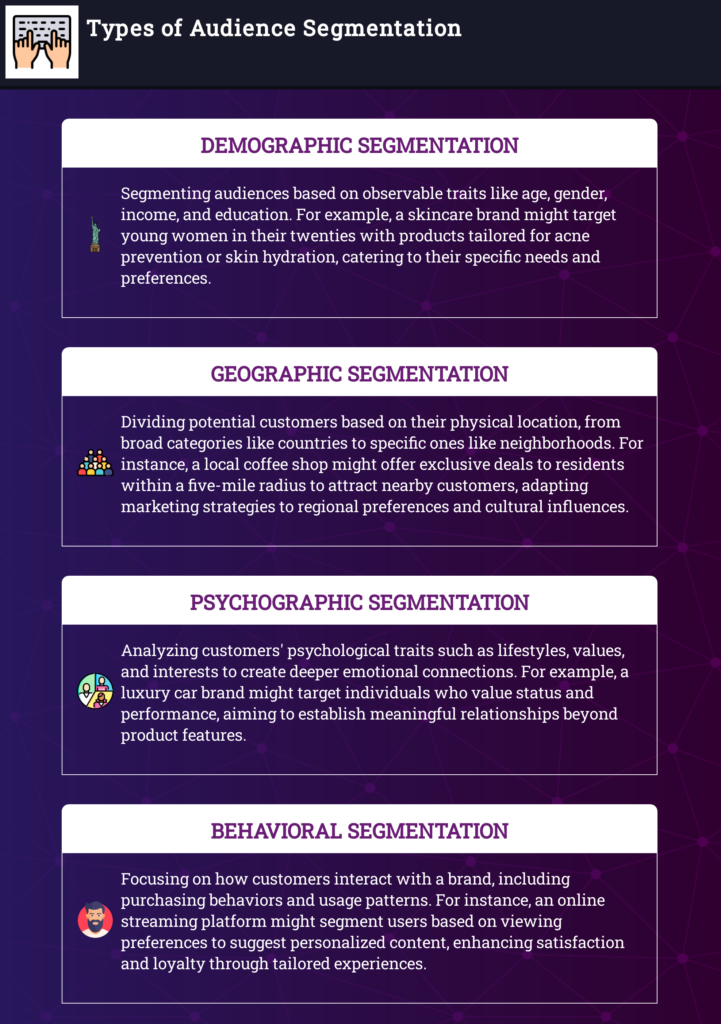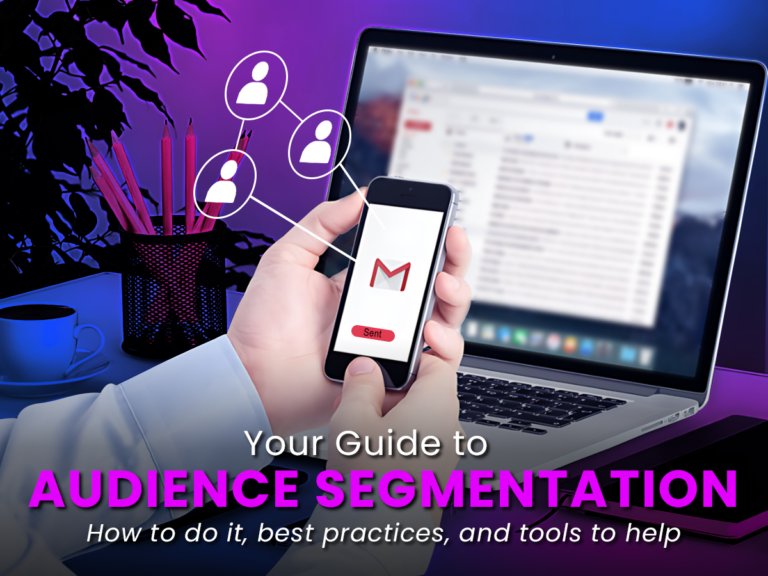Audience segmentation is important in helping businesses develop personalized, impactful, and efficient marketing strategies. In this blog post, we will explain what segmenting your audience means, why it’s important, and how to do it correctly.
What Does It Mean to Segment an Audience?
Segmenting an audience involves dividing a broad audience into smaller groups based on common characteristics. These characteristics can vary from basic demographics to more intricate behavioral traits. The main objective is to customize your communication and marketing strategies to resonate deeply with each specific subgroup, enhancing relevance and engagement.
The Importance of Audience Segmentation and Who Benefits
Why is segmenting your audience essential, and who stands to gain from it? It’s crucial for anyone seeking to refine their marketing efforts by making them more focused, efficient, and successful. Picture having a one-on-one conversation with someone where you tailor the discussion based on what you know about them. This is akin to what businesses achieve through segmentation. They identify the preferences of each customer group and adjust their messages accordingly to align with those preferences.
When people feel like a brand understands and values them, it creates a sense of connection and makes them feel special, almost like receiving a personalized birthday card just for them. Let’s break down five key reasons you should consider segmenting your audiences:
1. Improved Customer Retention
Companies can enhance customer satisfaction and loyalty by catering to the unique needs and wants of diverse customer groups. When customers feel acknowledged and appreciated, they are more inclined to remain loyal to a brand in the long run. It’s similar to how your favorite café remembers your usual order; this personal touch encourages you to keep coming back.
2. Targeted Marketing Strategies
Segmentation enables the development of tailored and impactful marketing strategies. By honing in on the preferences and behaviors of specific demographics, businesses can create campaigns that resonate more effectively and drive desired actions, whether it’s signing up, making a purchase, or achieving other conversion objectives. It’s like receiving a recommendation for a book perfectly aligned with your tastes – increasing your likelihood of reading it.
3. Enhanced Competitive Advantage
Audience segmentation empowers companies to identify untapped needs or overlooked market segments, allowing them to position themselves uniquely and competitively. This distinction can determine whether you’re just another choice or the preferred option for a specific set of customers.
4. Data-Driven Decisions
Segmentation offers valuable insights that can influence broader business strategies beyond marketing, such as sales tactics, customer service approaches, and strategic partnerships. This abundance of data ensures that decisions are based on real-world observations rather than assumptions.
5. Consistent Communication Across Various Channels
By segmenting effectively, a brand ensures its message maintains uniformity across all communication platforms, be it email, social media, or traditional advertising. This uniformity strengthens the brand’s tone and identity, boosting recognition and trust among its audience.
Segmenting your audience goes beyond just delivering better advertisements; it changes how businesses engage with their customers, allocate resources, and even determine their product offerings. It’s indispensable for those seeking to elevate their marketing strategies and establish genuine connections with their target market.
B2C vs. B2B: What’s the Difference?
B2C Audience Segmentation
In B2C scenarios, companies sell directly to individuals. The emphasis is placed on personal characteristics like age, income level, and individual preferences. For instance, a music streaming platform could cater to younger listeners by curating playlists that align with their interests. The goal is to resonate with individual preferences since purchasing choices are often influenced by personal desires.
B2B Audience Segmentation
On the other hand, B2B enterprises market their products or services to other businesses. Segmentation is based on business-specific factors like industry type or company size. For instance, a software vendor might target small tech businesses. In this scenario, purchases are made with organizational objectives in mind, typically involving a longer decision-making process and multiple decision-makers.
Key Differences:
Decision-making: B2C decisions are typically rapid and individual-driven, whereas B2B decisions involve more deliberation and collaboration among stakeholders.
Communication: B2C marketing often adopts a casual tone and leverages broad platforms like social media. In contrast, B2B communication tends to be more formal, utilizing professional channels.
Sales Cycle: The sales cycle in B2C is shorter and emphasizes immediate transactions, while in B2B settings, it is lengthier and focuses on cultivating long-term relationships.
Recognizing these differences enables companies to tailor their approaches effectively to engage their target audience— individuals or other businesses.
Types of Audience Segmentation and Examples
Before crafting a message or launching a campaign, it’s essential to narrow down the recipients. Segmenting the audience involves dividing the vast pool of viewers into specific groups, making marketing strategies more targeted and impactful. By comprehending the different types of segmentation, companies can create messages that deeply connect with their audience, whether they are promoting skincare items or streaming platforms. Let’s explore the various segmentation methods and how they can be applied.

Demographic Segmentation
Demographic segmentation categorizes the market based on observable characteristics like age, gender, income, and education level. It stands out as one of the simplest yet most influential forms of segmentation. For instance, a skincare brand might concentrate its marketing efforts on young women in their twenties by highlighting products designed for acne prevention or skin hydration tailored to youthful skin. This approach enables businesses to customize their products and marketing campaigns to suit the specific requirements and preferences of a particular demographic group, making their offerings more pertinent and attractive.
Geographic Segmentation
Geographic segmentation classifies potential customers according to their physical location, ranging from broad categories such as countries or states to more specific ones like cities or neighborhoods. This technique proves beneficial for businesses whose products or services exhibit varying levels of popularity in different regions. For example, a local coffee shop could send exclusive discount deals to residents living within a five-mile radius to draw in nearby clientele. Geographic segmentation enables businesses to tailor their marketing strategies according to regional preferences, climate conditions, and local cultural influences.
Psychographic Segmentation
This method goes beyond surface-level traits to explore the psychological characteristics of customers, including their lifestyles, values, interests, and personality features. Psychographic segmentation is essential for brands aiming to establish a deeper emotional connection with consumers. For instance, a luxury car brand might target individuals who appreciate not only the practical aspects of a vehicle but also the status and performance associated with owning a high-end car. By understanding consumers’ deeper motivations and priorities, businesses can create stronger and more meaningful relationships with their target audience.
Behavioral Segmentation
Behavioral segmentation focuses on how customers engage with a brand or product, including their purchasing behaviors, usage patterns, and interaction with marketing efforts. It involves observing consumer actions and categorizing them accordingly. For example, an online streaming platform could segment its users based on their viewing preferences, such as favorite genres or binge-watching habits, to suggest TV shows and movies. This type of segmentation allows companies to personalize their offerings and communications based on real consumer behavior, ultimately leading to improved satisfaction and loyalty.
Tips for Effective Audience Segmentation
It is important to employ segmentation thoughtfully to ensure your marketing endeavors are not guesswork. Here are some strategies to refine your approach to segmenting your audience, ensuring every marketing action reaches the right individuals most effectively.
1. Start with Clear Objectives
Before delving into segmentation strategies, identify the specific outcomes you seek. Whether it involves increasing sales within a particular age bracket, enhancing engagement in a specific location, or introducing a new product to a distinct lifestyle segment, having precise objectives establishes the foundation for your segmentation plan. This clarity guarantees that every decision – from the types of segmentation utilized to the channels selected for campaigns – is guided by a commitment to achieving these goals.
2. Use a Variety of Segmentation Types
Avoid confining yourself to just one type of segmentation approach. Integrating demographic, geographic, psychographic, and behavioral insights offers a comprehensive perspective on your audience. For example, understanding that your target audience consists of women in their thirties (demographic) residing in urban areas (geographic), valuing sustainability (psychographics), and frequently engaging in online shopping (behavioral) can assist you in creating highly relevant and persuasive messages.
3. Leverage Data Analytics
To delve deeper into your target segments, utilize data analytics. Utilizing tools and platforms that analyze customer data can reveal patterns and preferences that may not be immediately apparent. These insights enable you to customize your strategies based on actual behavior and feedback, ensuring your marketing efforts resonate with the desired audience. Regularly delving into this data keeps your strategies current and aligned with evolving customer behaviors.
4. Experiment and Refine
Audience segmentation is not a one-time task; it requires continuous refinement. Continuously experiment with how different segments respond to your marketing initiatives, and be prepared to adjust your approach based on the results. This process helps you remain relevant and responsive to your audience’s changing needs and preferences, ensuring that your segmentation remains effective over time.
5. Prioritize Privacy
Ensure your segmentation and marketing strategies adhere to all relevant data protection regulations and ethical guidelines. Respecting the privacy of your audience is crucial not only for legal compliance but also for fostering trust with your customers and establishing your brand’s image as a reliable and ethical entity.
Audience Segmentation Tools
Having the appropriate resources can make a significant impact. Each tool has unique strengths tailored for various segmentation aspects, ranging from analyzing behaviors to directly engaging for feedback.
Google Analytics
Google Analytics provides detailed insights into the demographics of your website visitors, the pages they engage with most, and their journey across your site. This valuable information is like striking gold when it comes to customizing your website and content to match what your audience desires perfectly.
Facebook Insights
If your target audience spends time on Facebook, then utilizing Facebook Insights is akin to having exclusive access behind the scenes to discover what piques their interest. This tool provides insights into the demographics such as age, gender, location and even the peak times when your followers are most active. Understanding these trends can assist you in determining the type of content to share, the optimal posting times and refining your strategies to enhance engagement on your page.
HubSpot
Consider HubSpot as a versatile tool in your arsenal for segmenting audiences. It serves as a multifaceted platform that provides data and facilitates actionable steps based on it. HubSpot enables you to segment your audience according to their behaviors and preferences by tracking user interactions across emails, social media platforms, and websites. This functionality simplifies personalizing marketing endeavors ranging from email campaigns to developing content.
SurveyMonkey
At times, the most effective approach for understanding your audience is by directly engaging with them. SurveyMonkey acts as a direct conduit to tap into your audience’s insights. It empowers you to craft detailed surveys aimed at gathering feedback on various aspects, including product preferences and purchasing patterns. This straightforward feedback is incredibly valuable for honing your segmentation and ensuring that your strategies are well-aligned with the needs and desires of your audience.
Each of these tools provides a unique perspective to observe and comprehend your audience better. By choosing the ones that align most closely with your objectives and the intricacy of your segmentation endeavors, you can develop a more thorough and efficient approach to connect with and captivate your target demographic.
How Otter PR Can Help
For entrepreneurs and marketers, understanding your audience is crucial for online interactions. It means talking directly to those who are interested and making every word count. That’s where Otter PR can help. We specialize in connecting you with the right audience through PR and lead-generation services. Think of us as your partner in getting your message across to the right people. With our expertise, you’re not just reaching out—you’re connecting and expanding your audience.











